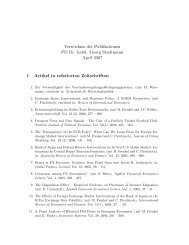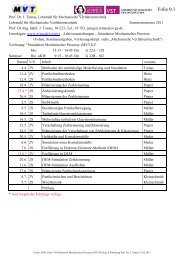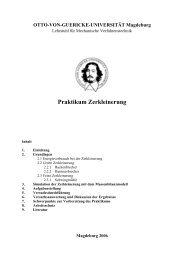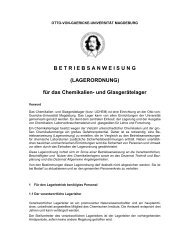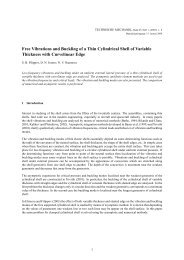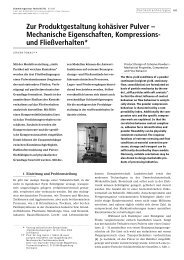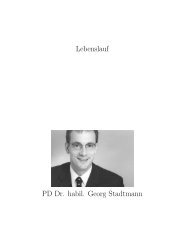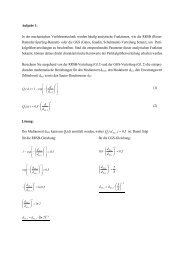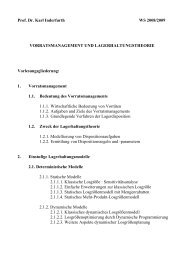Mechanics of nanoparticle adhesion â A continuum approach
Mechanics of nanoparticle adhesion â A continuum approach
Mechanics of nanoparticle adhesion â A continuum approach
You also want an ePaper? Increase the reach of your titles
YUMPU automatically turns print PDFs into web optimized ePapers that Google loves.
2J. Tomasfeeding and dosing, as well as undesired effects such as widely spread residencetime distribution, time consolidation or caking, chemical conversions and deterioration<strong>of</strong> bioparticles. Finally, insufficient apparatus and system reliability <strong>of</strong>powder processing plants are also related to these flow problems. The rapid increasingproduction <strong>of</strong> cohesive to very cohesive nanopowders, e.g., very adheringpigment particles, micro-carriers in biotechnology or medicine, auxiliary materialsin catalysis, chromatography or silicon wafer polishing, make theseproblems much serious. Taking into account this list <strong>of</strong> technical problems andhazards, it is essential to deal with the fundamentals <strong>of</strong> particle <strong>adhesion</strong>, powderconsolidation and flow, i.e. to develop a reasonable combination <strong>of</strong> particle and<strong>continuum</strong> mechanics.The well-known failure hypotheses <strong>of</strong> Tresca, Coulomb and Mohr and Druckerand Prager (in Refs. [1, 2]), the yield locus concept <strong>of</strong> Jenike [3, 4] and Schwedes[5], the Warren–Spring equations [6–10], and the <strong>approach</strong> by Tüzün [12], etc.,were supplemented by Molerus [13–16] to describe the cohesive, steady-stateflow criterion. Nedderman [17, 18], Jenkins [19] and others discussed the rapidand collisional flow <strong>of</strong> non-adhering particles, as well as Tardos [20] discussedthe frictional flow for compressible powders without any cohesion from the fluidmechanics point <strong>of</strong> view. Additionally, the simulation <strong>of</strong> particle dynamics <strong>of</strong> freeflowing granular media is increasingly used, see, e.g., Cundall [21], Campbell[22], Walton [23, 24], Herrmann [25] and Thornton [26].Additionally, particle <strong>adhesion</strong> effects are related to undesired powder blockingat conveyer transfer chutes or in pneumatic pipe bends [27] in powder handlingand transportation, to desired particle cake formation on filter media [28, 29], towear effects <strong>of</strong> adhering solid surfaces [30, 31], fouling in membrane filtration,fine particle deposition in lungs, formulation <strong>of</strong> particulate products [32–35] or tosurface cleaning <strong>of</strong> silicon wafers [36–40, 133], etc.The force–displacement behaviors <strong>of</strong> elastic, elastic–<strong>adhesion</strong>, plastic–<strong>adhesion</strong>, elastic–plastic, elastic–dissipative, plastic–dissipative and viscoplastic–<strong>adhesion</strong> contacts are shown. Based on these individual theories, a general <strong>approach</strong>for the time and deformation rate dependent and combined viscoelastic,plastic, viscoplastic, <strong>adhesion</strong> and dissipative behaviors <strong>of</strong> a spherical particlecontact is derived and explained.2. PARTICLE CONTACT CONSTITUTIVE MODELSIn terms <strong>of</strong> particle technology, powder processing and handling, Molerus [13,14] explained the consolidation and non-rapid flow <strong>of</strong> dry, fine and cohesivepowders (particle diameter d < 10 µm) in terms <strong>of</strong> the <strong>adhesion</strong> forces at particlecontacts. In principle, there are four essential mechanical deformation effects inparticle–surface contacts and their force–response (stress-strain) behavior can beexplained as follows (Table 1):



